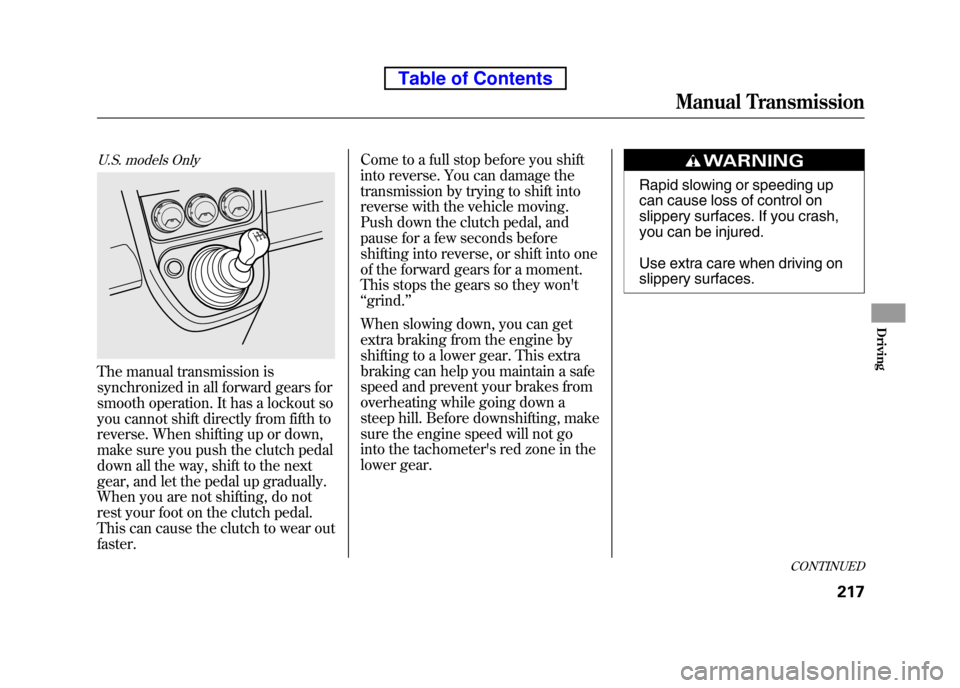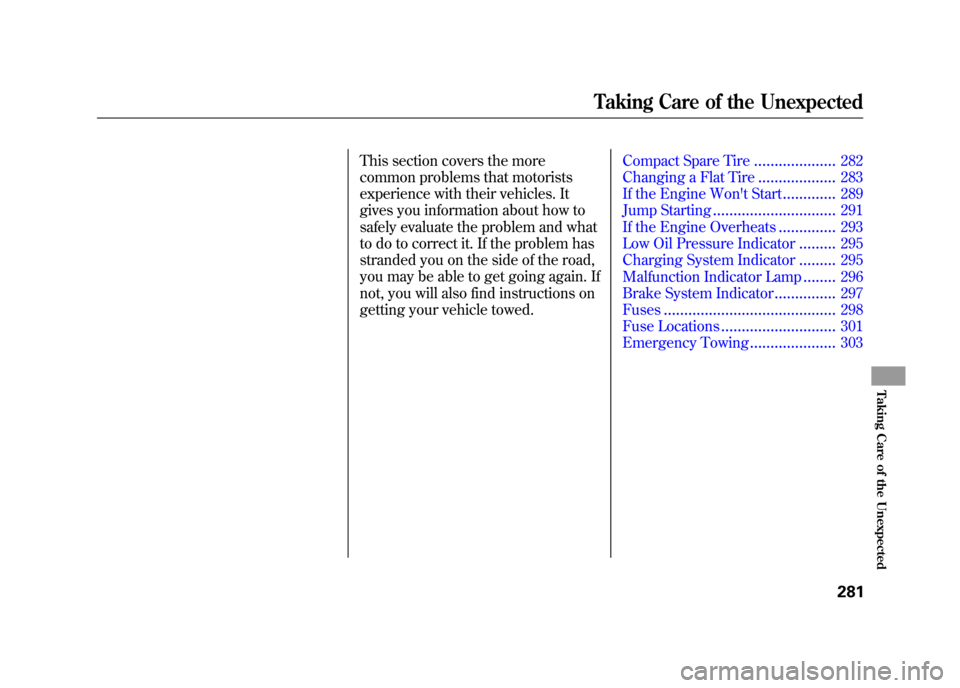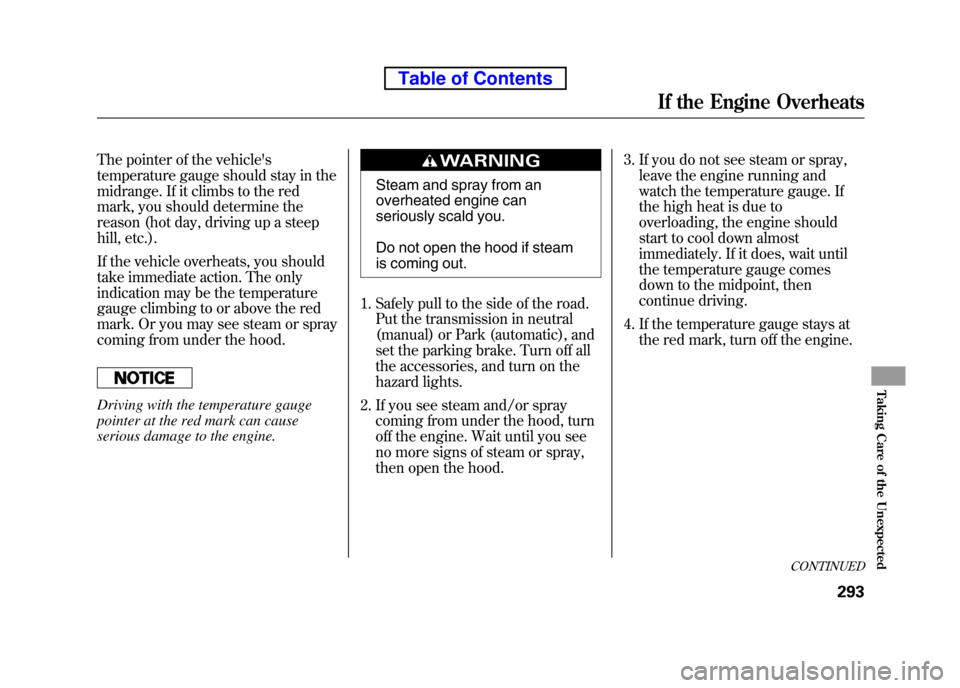engine overheat HONDA ELEMENT 2010 1.G Owners Manual
[x] Cancel search | Manufacturer: HONDA, Model Year: 2010, Model line: ELEMENT, Model: HONDA ELEMENT 2010 1.GPages: 342, PDF Size: 5.76 MB
Page 3 of 342

Cup Holders................................. 99
Customer Service .......................322
D
DANGER, Explanation of .............iii
Dashboard ............................... 3, 56
Daytime Running Lights ..............72
Daytime Running Lights
Indicator ................................... 60
Dead Battery .............................. 291
Defects, Reporting Safety (U.S. only) ....................................... 324
Defogger, Rear Window ...............74
Dimensions ................................ 308
Dimming the Headlights ..............71
Dipstick Automatic Transmission .........256
Engine Oil ............................... 201
Directional Signals .................60, 71
Disc Brake Wear Indicators .......225
Disc Care ................................... 183
Disc Changer Error
Messages ............................... 126Disc Player Error
Messages ........................ 125, 148
Disposal of Used Oil ...................253
Doors
Indicator ................................... 11
Locking and Unlocking ............80
Power Door Locks ...................80
DOT Tire Quality Grading (U.S. Vehicles) ................................ 311
Downshifting, Manual Transmission .......................... 217
Driver and Passenger Safety ..........5
Driving ....................................... 213
Economy ................................. 202
Driving Guidelines .....................214
Dust and Pollen Filter ................269
E
Economy, Fuel ........................... 202
Emergencies on the Road ..........281
Battery, Jump Starting .............291
Brake System Indicator .....58, 297
Changing a Flat Tire ...............283Charging System
Indicator ........................ 58, 295
Checking the Fuses ................298
Driving with a Flat Tire ...........282
Hazard Warning Flashers ........73
Jump Starting .......................... 291
Low Oil Pressure
Indicator ........................ 58, 295
Malfunction Indicator Lamp ............................. 58, 296
Overheated Engine .................293
Towing .................................... 303
Emergency Brake ........................94
Emergency Flashers ....................73
Emergency Towing ....................303
Emissions Controls ....................316
Emissions Testing ......................319
CONTINUED
Index
III
INDEX
Page 4 of 342

EngineAdding Engine Coolant ...........254
Coolant Temperature Gauge ....67
If it Won't Start ........................289
Malfunction Indicator Lamp ............................. 58, 296
Oil Life Indicator .....................243
Oil Pressure Indicator .......58, 295
Oil, What Kind to Use .............251
Overheating ............................ 293
Specifications .......................... 308
Speed Limiter ..................218, 221
Starting ................................... 216
Engine Coolant .......................... 254
Engine Number .........................307
Ethanol in Gasoline ....................198
Evaporative Emissions Controls .................................. 316
Exhaust Fumes ............................ 52
Expectant Mothers, Use of Seat Belts by .................................... 16
F
Fan, Interior ............................... 105Features
..................................... 103
Filters
Dust and Pollen .......................269
Oil ........................................... 252
Flashers, Hazard Warning ...........73
Flat Tire, Changing a .................283
Floor Mats ................................. 268
Fluids Automatic Transmission .........256
Brake ...................................... 258
Clutch ..................................... 258
Location .................................. 250
Manual Transmission ..............257
Power Steering ........................260
Rear Differential ......................258
Windshield Washer .................255
FM/AM Radio Reception ...........186
Folding the Rear Seats .................88
Four-way Flashers ........................73
Front Airbags ........................... 9, 25
Front Seat
Adjusting .................................. 83
Fuel ............................................ 198
Check Fuel Cap Message ........66
Economy ................................. 202
Fill Door and Cap ....................199Gauge
...................................... 66
Low Fuel Indicator ...................61
Octane Requirement ...............198
Reserve Indicator .....................61
Tank, Filling the ......................199
Fuel Economy ............................ 202
Fuses, Checking the ..................298
G
Gas Mileage, Improving .............203
Gasoline ..................................... 198
Gauge ...................................... 66
Low Fuel Indicator ...................61
Octane Requirement ...............198
Tank, Refueling .......................199
Gas Station Procedures ..............199
Gauges Engine Coolant Temperature ...67
Fuel .......................................... 66
Odometer ................................. 65
Outside Temperature Indicator ............................... 68
Speedometer ............................ 64
Tachometer .............................. 64
Index
IV
Page 7 of 342

Modifications............................. 206
Modifying Your Vehicle .............206
N
Neutral Gear Position .................220
New Vehicle Break-in .................198
Normal Shift Speeds ..................218
NOTICE, Explanation of ................i
Numbers, Identification .............306
O
Octane Requirement, Gasoline ................................. 198
Odometer ..................................... 65
Off-Highway Driving Guidelines .............................. 238
Off-Road Precautions ..................238
Oil Change, How to ......................252
Change, When to ....................243
Checking Engine ....................201
Life, Engine ............................. 243
Pressure Indicator .............58, 295 Selecting Proper Viscosity
Chart ................................... 251
Onboard Refueling Vapor Recovery ................................ 316
ON (Ignition Key Position) ..........79
Outside Mirrors ........................... 93
Outside Temperature Indicator ....68
Overhead Console ......................101
Overheating, Engine ..................293
Owner's Maintenance Checks ....248
Oxygenated Fuels ......................198
PPanel Brightness Control .............72
Park Gear Position .....................219
Parking ...................................... 223
Parking Brake .............................. 94
Parking Brake and Brake System Indicator ........................... 58, 297
Parking Over Things that
Burn ................................ 223, 318
Passenger Airbag Off Indicator ....32
PGM-FI System .......................... 317
Playing a Disc .....................119, 140Playing an iPod
®.........................
162
Playing a PC card .......................149
Playing a USB Flash Memory Device .................................... 173
Playing the FM/AM Radio ............................... 110, 127
Playing the XM
®Radio ........113, 132
Pollen Filter ............................... 269
Power Door Locks .......................80
Power Socket Locations .............100
Power Steering Fluid .................260
Power Windows ........................... 92
Pregnancy, Using Seat Belts ........16
Preparing to Drive ......................215
Proper Seat Belt Usage ................14
Protecting Adults and Teens ........11
Additional Safety Precautions ...16
Advice for Pregnant Women ....16
CONTINUED
Index
VII
INDEX
Page 8 of 342

Protecting Children......................35
General Guidelines ..................35
Protecting Infants .....................40
Protecting Larger Children ......49
Protecting Small Children ........41
Using Child Seats with Tethers ................................. 48
Using LATCH .......................... 44
R
Radiator Overheating .................293
Radio/CD Sound System ...........109
Radio Theft Protection ...............188
Readiness Codes ........................319
Rear Differential Fluid ................258
Rear Lights, Bulb Replacement ........................... 266
Rear Seat, Folding ........................88
Rearview Camera and Monitor .................................. 196
Rearview Mirror ........................... 93
Rear Window Defogger ................74
Rear Window Wiper and Washer ..................................... 70Reclining the Front Seats
.............87
Recommended Shift Speeds .......218
Refueling .................................... 199
Reminder Indicators .....................58
Remote Audio Controls ..............191
Remote Transmitter .....................77
Replacement Information
Dust and Pollen Filter .............269
Engine Oil and Filter ...............252
Fuses ...................................... 298
Light Bulbs ............................. 261
Schedule ................................. 249
Spark Plugs ............................. 308
Tires ....................................... 274
Wiper Blades .......................... 269
Replacing Seat Belts After a Crash ........................................ 20
Reporting Safety Defects (U.S. Vehicles) ................................ 324
Reserve Tank, Engine Coolant ............................ 201, 254
Restraint, Child ............................ 35
Reverse Gear Position ................220
Reverse Lockout ........................217
Rotation, Tire ............................. 274S
Safety Belts
.............................. 8, 18
Safety Defects, Reporting (U.S. only) ....................................... 324
Safety Features .............................. 7
Airbags ................................. 9, 22
Head Restraints ........................13
Seat Belts ........................ 8, 14, 18
Seats & Seat-Backs ..............11, 12
Safety Labels, Location of .............53
Safety Messages ..........................iii
Seat Adjustments .........................83
Seat Belts ................................. 8, 18
Additional Information .............18
Advice for Pregnant Women ....16
Automatic Seat Belt
Tensioners ........................... 20
Cleaning .................................. 268
Lap/Shoulder Belt ..............14, 19
Maintenance ............................ 20
Reminder Indicator and Beeper ............................. 18, 58
System Components ................18
Use During Pregnancy .............16
Index
VIII
Page 17 of 342

Your Vehicle at a Glance(main controls).................................................................................................................... 3
Driver and Passenger Safety (seat belts, SRS, and child protection) ........................................................................... 5
Instruments and Controls (indicators, gauges, dashboard, and steering column) ....................................................55
Features (heating and cooling, audio, steering wheel, cruise control, and other convenience items) ......................103
Before Driving (fuel, vehicle break-in, and cargo loading) ....................................................................................... 197
Driving (engine and transmission operation) ........................................................................................................... 213
Maintenance (minder, fluid checking, minor services, and vehicle storage) ...........................................................241
Taking Care of the Unexpected (flat tire, jump starting, overheating, and fuses) ...................................................281
Technical Information (vehicle specifications, tires, and emissions controls) ........................................................305
Warranty and Customer Relations (U.S. and Canada only) (warranty and contact information)........................321
Index .............................................................................................................................................................................. I
INDEX
Service Information Summary(fluid capacities and tire pressures) ............................................................... last page
Contents
1
Page 233 of 342

U.S. models Only
The manual transmission is
synchronized in all forward gears for
smooth operation. It has a lockout so
you cannot shift directly from fifth to
reverse. When shifting up or down,
make sure you push the clutch pedal
down all the way, shift to the next
gear, and let the pedal up gradually.
When you are not shifting, do not
rest your foot on the clutch pedal.
This can cause the clutch to wear out faster.Come to a full stop before you shift
into reverse. You can damage the
transmission by trying to shift into
reverse with the vehicle moving.
Push down the clutch pedal, and
pause for a few seconds before
shifting into reverse, or shift into one
of the forward gears for a moment.
This stops the gears so they won't‘‘
grind. ’’
When slowing down, you can get
extra braking from the engine by
shifting to a lower gear. This extra
braking can help you maintain a safe
speed and prevent your brakes from
overheating while going down a
steep hill. Before downshifting, make
sure the engine speed will not go
into the tachometer's red zone in the
lower gear.
Rapid slowing or speeding up
can cause loss of control on
slippery surfaces. If you crash,
you can be injured.
Use extra care when driving on
slippery surfaces.
CONTINUED
Manual Transmission
217
Driving
Table of Contents
Page 243 of 342

Your vehicle is equipped with a tire
pressure monitoring system (TPMS)
that turns on every time you start the
engine and monitors the pressure in
your tires while driving.
Each tire has its own pressure sensor
(not including the spare tire). If the
air pressure of a tire becomes
significantly low, the sensor in that
tire immediately sends a signal that
causes the low tire pressure indicator
to come on.Low Tire Pressure Indicator
When the low tire pressure indicator
is on, one or more of your tires is
significantly underinflated. You
should stop and check your tires as
soon as possible, and inflate them to
the proper pressure as indicated on
the vehicle's tire information placard.
If you think you can safely drive a
short distance to a service station,
proceed slowly, and inflate the tire to
the recommended pressure shown
on the driver's doorjamb.
If the tire is flat, or if the tire pressure
is too low to continue driving, replace
the tire with the compact spare tire
(see page 282). If you cannot make the low tire
pressure indicator go out after
inflating the tires to the specified
values, have your dealer check the
system as soon as possible.
Driving on a significantly
underinflated tire causes the tire to
overheat and can lead to tire failure.
Underinflation also reduces fuel
efficiency and tire tread life, and may
affect the vehicle's handling and
stopping ability.
Because tire pressure varies by
temperature and other conditions,
the low tire pressure indicator may
come on unexpectedly.
CONTINUED
Tire Pressure Monitoring System (TPMS)
227
Driving
Table of Contents
Page 253 of 342

Making Turns and Braking
Make turns more slowly and wider
than normal. The trailer tracks a
smaller arc than your vehicle, and it
can hit or run over something the
vehicle misses. Allow more time and
distance for braking. Do not brake or
turn suddenly as this could cause the
trailer to jackknife or turn over.
Driving on Hills
When climbing hills, closely watch
your temperature gauge. If it nears
the red (Hot) mark, turn the air
conditioning off, reduce speed and, if
necessary, pull to the side of the road
to let the engine cool.
If the automatic transmission shifts
frequently while going up a hill, shift
to D3.If you must stop when facing uphill,
use the foot brake or parking brake.
Do not try to hold the vehicle in place
by pressing on the accelerator, as
this can cause the automatic
transmission to overheat.
When driving down hills, reduce
your speed, and shift down to second
gear. Do not
‘‘ride ’’the brakes, and
remember, it will take longer to slow
down and stop when towing a trailer.
Handling Crosswinds and Buffeting
Crosswinds and air turbulence
caused by passing trucks can disrupt
your steering and cause the trailer to
sway. When being passed by a large
vehicle, keep a constant speed, and
steer straight ahead. Do not try to
make quick steering or brakingcorrections.
Backing Up
Always drive slowly and have
someone guide you when backing
up. Grip the
bottomof the steering
wheel, then turn the wheel to the left
to get the trailer to move to the left,
and turn the wheel right to move the
trailer to the right.
Parking
Follow all normal precautions when
parking, including firmly setting the
parking brake and putting the
transmission in Park (automatic) or
in 1st or reverse (manual). Also,
place wheel chocks at each of the
trailer's tires.
Towing Your Vehicle
Your vehicle is not designed to be
towed behind a motor home. If your
vehicle needs to be towed in an
emergency, see page 303.
Towing a Trailer
237
Driving
Table of Contents
Page 297 of 342

This section covers the more
common problems that motorists
experience with their vehicles. It
gives you information about how to
safely evaluate the problem and what
to do to correct it. If the problem has
stranded you on the side of the road,
you may be able to get going again. If
not, you will also find instructions on
getting your vehicle towed.Compact Spare Tire....................282
Changing a Flat Tire ...................
283
If the Engine Won't Start .............289
Jump Starting ..............................
291
If the Engine Overheats ..............293
Low Oil Pressure Indicator .........
295
Charging System Indicator .........295
Malfunction Indicator Lamp ........296
Brake System Indicator ...............
297
Fuses .......................................... 298
Fuse Locations ............................
301
Emergency Towing .....................303
Taking Care of the Unexpected
281
Taking Care of the Unexpected
Page 309 of 342

The pointer of the vehicle's
temperature gauge should stay in the
midrange. If it climbs to the red
mark, you should determine the
reason (hot day, driving up a steep
hill, etc.).
If the vehicle overheats, you should
take immediate action. The only
indication may be the temperature
gauge climbing to or above the red
mark. Or you may see steam or spray
coming from under the hood.
Driving with the temperature gauge
pointer at the red mark can cause
serious damage to the engine.
Steam and spray from an
overheated engine can
seriously scald you.
Do not open the hood if steam
is coming out.
1. Safely pull to the side of the road. Put the transmission in neutral
(manual) or Park (automatic), and
set the parking brake. Turn off all
the accessories, and turn on the
hazard lights.
2. If you see steam and/or spray coming from under the hood, turn
off the engine. Wait until you see
no more signs of steam or spray,
then open the hood. 3. If you do not see steam or spray,
leave the engine running and
watch the temperature gauge. If
the high heat is due to
overloading, the engine should
start to cool down almost
immediately. If it does, wait until
the temperature gauge comes
down to the midpoint, then
continue driving.
4. If the temperature gauge stays at the red mark, turn off the engine.
CONTINUED
If the Engine Overheats
293
Taking Care of the Unexpected
Table of Contents